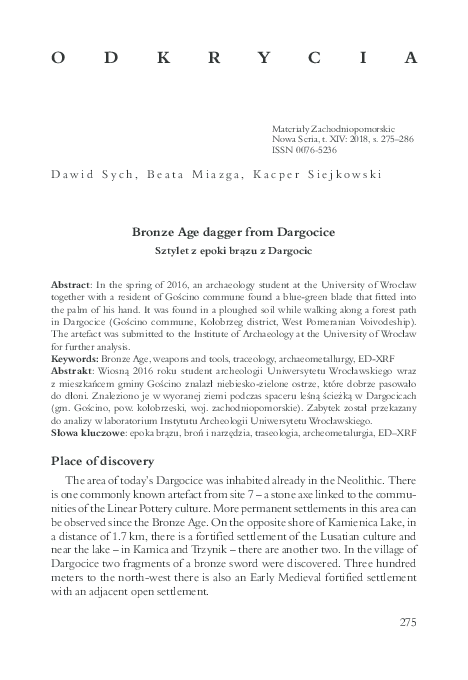O
D
K
R
Y
C
I
A
MateriałyZachodniopomorskie
NowaSeria,t.XIV:2018,s.275–286
ISSN0076-5236
Dawid Sych, Beata Miazga, Kacper Siejkowski
BronzeAgedaggerfromDargocice
SztyletzepokibrązuzDargocic
Abstract: In the spring of 2016, an archaeology student at the University of Wrocław
togetherwitharesidentofGościnocommunefoundablue-greenbladethatfittedinto
thepalmofhishand.Itwasfoundinaploughedsoilwhilewalkingalongaforestpath
in Dargocice (Gościno commune, Kołobrzeg district, West Pomeranian Voivodeship).
TheartefactwassubmittedtotheInstituteofArchaeologyattheUniversityofWrocław
forfurtheranalysis.
Keywords:BronzeAge,weaponsandtools,traceology,archaeometallurgy,ED-XRF
Abstrakt: Wiosną 2016 roku student archeologii Uniwersytetu Wrocławskiego wraz
z mieszkańcem gminy Gościno znalazł niebiesko-zielone ostrze, które dobrze pasowało
dodłoni.ZnalezionojewwyoranejziemipodczasspaceruleśnąścieżkąwDargocicach
(gm. Gościno, pow. kołobrzeski, woj. zachodniopomorskie). Zabytek został przekazany
doanalizywlaboratoriumInstytutuArcheologiiUniwersytetuWrocławskiego.
Słowakluczowe:epokabrązu,brońinarzędzia,traseologia,archeometalurgia,ED–XRF
Placeofdiscovery
Theareaoftoday’sDargocicewasinhabitedalreadyintheNeolithic.There
isonecommonlyknownartefactfromsite7–astoneaxelinkedtothecommunitiesoftheLinearPotteryculture.Morepermanentsettlementsinthisareacan
beobservedsincetheBronzeAge.OntheoppositeshoreofKamienicaLake,in
adistanceof1.7km,thereisafortifiedsettlementoftheLusatiancultureand
nearthelake–inKamicaandTrzynik–thereareanothertwo.Inthevillageof
Dargocicetwofragmentsofabronzeswordwerediscovered.Threehundred
meterstothenorth-westthereisalsoanEarlyMedievalfortifiedsettlement
withanadjacentopensettlement.
275
�Theplaceofthedagger’sdiscoveryislocatedintheareaofAZP18-16map,
where in total 19 archaeological sites are located which are mostly dated to
theEarlyMiddleAges.Therearealsohoardsandcemeteriesconnectedwith
thePomeranianculture,whichwerediscoveredaccidentallyinthe19thcentury.
FirstsystematicarchaeologicalresearchintheareaofKamienicaLakewasperformedinthe1960sasapartofexcavatingexpeditionofInstituteofMaterial
CultureofthePolishAcademyofSciencesinPoznań.Numerousfragmentsof
bronzeobjectswerefoundtherethatcamefromthegravesoftheLusatianor
Pomeranianculture.In2007,aresearchteamfromNicolausCopernicusUniversityinToruńdiscoveredahoardofbronzeobjectsdatedtotheLateBronze
AgeatthefootofTrzynikfortifiedsettlement,whichisdescribedassite12.
Itincludedweapons,ornamentsandtools(Rembisz-Lubiejewska2011).
Morphologyandchronology
Eventhoughawell-mineralisedlayerofdark-greenpatinaisvisibleonthe
surfaceofthedagger(Fig.1),whichconstitutesamechanicalprotectionfor
thecore,thestateofpreservationoftheartefactisnotgood.Itsbadcondition
ismostlyvisibleonthefracturesofthebladesthataredisintegratingsignificantly,exposingthehighlyoxidisedcross-section,wherethemetallicphaseisnot
presentoronlyitsresiduesarevisible(Fig.2).
The dagger from Dargocice is a continuation of weapon forms from the
Uneticeculture.Ithassemi-circularplateforthehandlewithtwoholesfor
rivets.Thebladeis118mmlonganditsmaximumwidthis28mm.Aribruns
throughthecentreoftheblade.Bothrivetshavebeenpreserved.Onthebasis
ofmorphologicalcharacteristicstheartefactmaybedatedtotheturnofthe
EarlyandMiddleBronzeAge,andmorepreciselytotheendofBA2phaseand
thebeginningofBB1phase(Dąbrowski2004,14).Ananalogicalitemisknown
fromSzczecin(Zdroje),WestPomeranianVoivodeship(Gedl1980,47Fig.108).
Traceologicalanalysis
Therearethreecategoriesoftracesvisibleonthedagger:(1)production
traces,(2)use-wearand(3)post-depositionaltraces.Alltraceswereregistered
withtheuseofportabledigitalmicroscopeConradwithphotographiccamera
withamatrixof10megapixelsandzoomof10xto200x.
Inthefirstcategorywemayincludelongparallellinesalongtheaxisonthe
basisofthedaggerhilt-platewhicharoseduringgrinding(Fig.3).Thisaction
wasmostprobablyperformedwiththepurposeofremovingthecastingdefects.
Diagonalandparallellinesfoundveryneartheblade’sedgesmaybetracesof
sharpeningandgrinding(Fig.4).Secondcategoryincludesnumerousdents
276
�andbluntnessontheworkingedge(Fig.5,6)aswellasaclearbendofthe
blade.Thethirdcategorycontainscorrosionandsingularscratchesextending
invariousdirections.
Baseforcomparisonconsistsof15daggersthatweresubjectedtotraceologicalanalysisfromSilesiaandadjoiningareas(Sych2016).Twoaredatedto
BA,threetoBB,twotoBB-BC,onetoBC,fourtoBC-BD,onetoBD-HA
and two to HB2-HB3. Six daggers come from graves, one from a hoard of
tools,weaponsandornaments,onefromasettlement,onewasdiscoveredin
an oxbow of Oder and remaining six are stray finds with unknown context
ofdiscovery.
Tracesvisibleontheartefactsallowedtodifferentiatebetweenthreelevels
ofusage:low,mediumandhigh.Daggerswithalowlevelofusagecontainan
insignificantnumberofuse-wearsuchasscratches,smalldentsandbluntness.
Mediumlevelofusageischaracterizedbythepresenceofscratches,largerdents,
bluntnessandbends.Objectswithhighlevelofusagehavenumerousdents,
bluntnessandbends,theyarealsocharacterizedbyaclearasymmetryofthe
workingedgeaswellascracksandfractures.Asidefromtheabove-mentioned
categorieswemaydifferentiateafourthone,consistingofdestroyedobjects.
Thesearetheobjectswhichrepairwasnotpossibleandremeltingthemwas
theonlyreasonablesolution.
Onalldaggerssubjectedtotraceologicalanalysiswemayobserveuse-wear
traces.Thosewithmedium(5)andlow(5)levelofusagearedominant,there
areafewlessdestroyedartefacts(4)andtheleastnumerousistheamountof
objectswithalowlevelofusage(1).Particularlynoteworthyisthelackofitems
withalowlevelofusageingravesanddominanceofartefactswithmediumand
highlevelofusageaswellasthosedestroyed.Theobservedproportionsmay,
however,beaneffectofasmallsample.DaggerfromDargociceischaracterized
byamediumlevelofusage.
Acommonfeatureofallenumerateddaggersisthecompletelackorsmall
numberofproductiontracessuchassurplusofmetal,porosityofthesurfaceor
hammering.Consideringthefactthatitemsanalysedfortracesofproduction
correspondchronologicallytothewholeBronzeAge,theinterpretationseems
tobecorrectthatadaggerwasapersonalobject,whichcreationinvolvedmore
effortthan,forexample,incaseofatool.Thus,itssurfacewaspreparedwith
muchmorecarebymeansofremovalofproductionprocessdefects.
Metalanalysis
Thepurposeoftheresearchwastodeterminetherawmaterialfromwhich
thedaggerwasmade,choosingnon-destructivemethods.Thus,theanalysisof
theelementalcompositionwasdonewiththeuseofEnergy-DispersiveX-ray
277
�Fluorescence,withSpectro-Midexspectrometer.Thedeviceisequippedwith
anX-raytubewithmolybdenumanode(voltage:46kV).Becauseoftheuseof
alargesamplechamber(54cm×42cm×16cm)andanintegratedvideo
camerasystemaswellas0.7mmmeasuringspotsizetheexactsamplepositioningwaspossible(Fig.1).Aseriesofrepetitionswasmadeonthedaggerwhich
providedrawmaterialdataonthebladeandtwopreservedrivets.
Due to the low state of artefact’s preservation and lack of conservation,
it was necessary to carefully clean its surface from layers of earth without
damagingthelayersofpatina.Thusprepared,theartefactwassubjectedto
archaeometricanalysis.
The dagger analysis has revealed that it was made of bronze, where the
averagetincontentreaches14%andcopperalmost84%.Percentageofother
componentsislessthan1%andtheseconsistsof:0.5%ofarsenicandnickel,
0.4%ofantimony(table1).Consistencyoftheresultsmaybeobservedduring
theanalysisofXRFspectra(Fig.7).Thestrongestanalyticalsignalsarethose
ofcopperandtin,weakersignalsofiron,nickel,arsenic,antimonyandlead
werealsoidentified.Analysingtheseresults,onemaynotforgetthatevenin
thecaseofsuchhighlyoxidisedartefact,itwaspossibletoidentifytheraw
materialandmoreover,theresultsofsamplepositioningarecharacterizedby
averysmalldispersion.However,itisnecessarytoincludethedataregardingahighlevelofoxidisationoftheartefactandthedifficultyinobtaining
the adequate amounts of metallic phase, which in case of the dagger was
extremelychallenging.
Thatiswhytheanalysisoftwopreservedrivetsprovedtobehighlycomplexedbutatthesametimeitrevealedinformationconfirmingthesubstantial
oxidationofthedagger’selements.However,duringthepreparationforanalysisitwasimpossibletogetaccesstothemetalphase.Bothrivetsarecovered
withconsiderablethicknessofoxidisedlayersthatwouldhavetobedestroyed
inordertoexposethenon-oxidisedmetalliccoreoftheseelements.Thatis
why, considering the need for preservation of the oxidised layers covering
therivets,theywereanalysedafteronlygentlecleaningshowingqualitative
andsemi-quantitativeresultsfortherawmaterial(however,duetotheprocessesofcorrosionthesemi-quantitativeanalysismaynotreflecttheoriginal
compositionofthealloy).Theresultsoftheelementalcompositionresearch
showthattherivetsweremadeofamaterialconsistingofcopper,tin,nickel,
iron, arsenic, antimony and lead (Fig. 8). The main elements are tin and
copper with tens of percent. Semi-quantitative analysis, revealing substantialconcentrationoftin(scope20-90%Sn)shouldbetreatedasaneffectof
corrosionprocess.Tin,asametallessnoblethancopper,isfirsttooxidise.
Asaresult,corrosivelayershavemoretinthantheoriginalalloy.Itissimilar
278
�withironandnickel,whereasarsenicandantimonyhavesimilarnobilityas
copper.Thus,theanalysisoftherivets’surfaceshouldnotbetreatedasrepresentativefortheoriginalalloy.
DaggersinthebasinsofVistulaandOder
Daggersareoneofthefirstweaponsthattheprehistoricsocietiesmadefrom
metal.Theoldestcopperitemsfromtheareaoftoday’sPolandaredatedtothe
oldChalcolithicPeriodandlinkedwithyoungerLengyel-Polgarculturalgroups
aswellastheFunnelbeakercultureandtheGlobularAmphoraculture.They
appearedlessoftenintheCordedWareculture.Daggershadtheapogeeoftheir
splendourintheEarlyandMiddleBronzeAge;lateron,withtheadventof
knivesandswords,theirsignificancedecreased,whichisclearlyvisibleinthe
numberoftheitemsfound(Blajer2001,116;Gedl1980,5–11).
Achangeinthesocialperceptionofdaggersmostlikelytookplaceinthe
EarlyBronzeAge,whichmanifestedindeposingtheminhoards.Theywere
rarelyputingraves,wheresometimestheywerefoundtogetherwithhalberds
and axes. A dagger was also found in a burial mound no. III in Łęki Małe,
Grodzisko district, Greater Poland Voivodeship, which was interpreted as
agraveoftherepresentativeoflocalelites.Use-wearandtracesofrepairin
theformofawireconnectingthebladetothehandleonthedaggerfromŁęki
Małesuggestthatitwasusedbeforeitwasdepositedinthegraveandmost
likelyitperformedamilitaryfunction.Itfollowsthat,adagger,nexttoaxes
andhalberdswasoneofthemainattributesofaman(Blajer1999,31–36;2001,
118–119;Sarnowska1969,70–82,107–112,tab.I).Itisnot,however,aruleon
anEuropeanscale.Daggersappearedalsoinwomen’sgraves,forexamplein
theMiddleBronzeAge,inScandinavia,insouth-easternHolstein.Itisclearly
visibletherethattheweaponsaremorecommonintheareasmoreproneto
conflicts, while their number in women’s graves decreases with increasing
numberofitemsofforeignorigin,suggestingtheestablishmentofmorepeacefulculturalcontacts.Itcanbethereforeassumedthatthedaggerswereusedby
womenforprotectionduringperiodsofincreasedthreatfromforeigngroups
(Bergerbrant2007,98–102).
AttheturnoftheEarlyandMiddleBronzeAgetheroleofadaggerasaman’s
attributeprobablybegantoincrease.InthearearesidedbytheTumulusculture
artefactsbeganmoreoftentoappearinburialmoundsandwererarelyfound
inhoards.Theyweredepositedtogetherwithaxesandarrowheads.Thisallowstoformulateaconclusionthattheywerealsoanattributeofawarrior
(Blajer1999,31–36;2001,119–120;Dąbrowski2004,15–16;Gedl1980,5–11).
Use-wear visible on blades of daggers from the Middle Bronze Age clearly
showsthattheitemsdepositedingraveswerenotceremonialormadepurely
279
�withtheintentionofburial(Pearson2000,85–86).Dominanceofdaggerscharacterizedbyahighlevelofusageinthesetofartefactssubjectedtotraceological
analysispointstoselectivenessofthedeposition.
Strayfindsalsocontainuse-wear,however,atthispointitisimpossibleto
settlewhichitemswerelostandwhichweredepositedinthegroundorwater intentionally. The exception is the dagger from Wrocław, Lower Silesian
Voivodeship,foundintheoxbowofOder,whichwasmostlikelyintentionally
thrownintotheriver.Theasymmetryofthebladeanddamagedrivetholes
pointsnotonlytonumerousrepairsbutmainlytointensiveuse.Use-wearis
visiblealsoontheornamentedspearheadfromWrocław-Różanki,LowerSilesianVoivodeshipdatedtothesameperiodfoundintheOder’soxbowandon
thebronzeswordfromLeśniki,Opoledistrict,OpoleVoivodeship,foundin
aswamp.Alloftheaboveclearlyindicatetheexistenceofstrictrulesgoverning
thedepositionofweaponsinthisperiod.
IntheMiddleandattheturnoftheMiddleandLateBronzeAgedaggers
wereoftenapartofgravesinventories,includingburialmoundsoftheKietrz
typeoftheLusatianculturethatareconnectedtotherepresentativesofthelocal
elites.Therefore,thetraditionthatbeganintheEarlyBronzeAgeisstillclearly
visible.Oneshouldnotethatalargepercentageofstrayfindswasdiscoveredin
theaquaticenvironment,whichcouldindicatethattherewasaneedtoremove
atleastapartofthedaggersfromthecirculation.Itisnotclearifthisshould
belinkedtotheburialritualortovotivegifts(Fogel1979,13–26;Gedl1984,
52–53,73–75;Blajer1999,31–36;2001,119–120).Use-wearintheformof
scratches,dents,bluntnessandbendsseetoconfirmthemilitaryfunctionof
theanalyseditems.
IntheLateBronzeAgeacleardecreaseintheamountofdaggersisvisible.
Intheareaswherebeforetheywerenumerous,therearealmostnofinds.Itis
assumedthattheroleofdaggersdeclinedinthefaceofincreasingpopularityof
swordsandknivesthatbecameconsideredastheiralternative(Fogel1979,13–26;
Gedl1980,5–11;Blajer2001,121–122).Theonlyitemthatwassubjectedto
traceologicalanalysisdatedtotheLateBronzeAgeistheCimmeriandagger,
whichwasapartofhoardfromGamów,Gliwicedistrict,SilesianVoivodeship,
containstracesofuse(intheformofnicksandaclearbendoftheblade),just
astwoswordsandaknifethatwerediscoveredtogetherwithit.
Acommonfeatureofalldaggerssubjectedtotraceologicalanalysisisthelack
ofproductiontraces.Duetothefactthatthediscussedartefactsdatebacktothe
wholeBronzeAge,itseemsappropriatetoassumethattheseweresopersonal
objectsthatmuchmoreeffortwasputintheircreationwhencomparedtothe
tools,andthereforetheirsurfacewasdevelopedwithmorecarebytheremoval
ofanyimperfectionsthataroseduringproduction.
280
�Table1.Theelementalcompositionofthedagger(%weight)
Tabela1.Składpierwiastkowysztyletu(%masy)
PreparedbyB.Miazga
281
�Literature
BergerbrantS.2007.BronzeAgeIdentities:Costume,ConflictandContactinNorthernEurope
1600–1300BC.Lindome.StockholmStudiesinArchaeology43.
BlajerW.1999.Skarbyzestarszejiśrodkowejepokibrązunaziemiachpolskich.Kraków.
Blajer W. 2001. Skarby przedmiotów metalowych z epoki brązu i wczesnej epoki żelaza na
ziemiachpolskich.Kraków.
DąbrowskiJ.2004.ÄltereBronzezeitinPolen.StarszaepokabrązuwPolsce.Warszawa.
FogelJ.1979.StudianaduzbrojeniemludnościkulturyłużyckiejwdorzeczuOdryiWisły.
Brońzaczepna.Poznań.
GedlM.1980.DieDolcheundStabdolcheinPolen.Münster.PrähistorischeBronzefundeV/4.
GedlM.1984.Wczesnołużyckiegrobyzkonstrukcjamidrewnianymi.Wrocław.
PearsonM.P.2000.TheArchaeologyofDeathandBurial.Teksas.
Rembisz-LubiejewskaA.2011.Darwotywnyzłożonyzozdób,narzędziibroniodkryty
w Jeziorze Kamienica, w miejscowości Trzynik, pow. Kołobrzeg (stanowisko 12)
/Jewellery,toolsandweaponfromtheKamienicaLake,TrzynikinKołobrzegdistrict(site12).ActaUniversitatisNicolaiCoperniciArcheologia31.Archeologiapodwodna
6,11–24.
SarnowskaW.1969.KulturaunietyckawPolsce.Wrocław–Warszawa–Kraków.
SychD.2016.Biografiekulturowemilitarióworaznarzędzimiedzianychibrązowychdatowanychnaneolitiepokębrązuzpołudniowo-zachodniejPolski.PhDDissertation.Insitute
ofArcheology,UniversityofWrocław.
BeataMiazga
InstytutArcheologiiUniwersytetuWrocławskiego
e-mail:beata.miazga@uwr.edu.pl
KacperSiejkowski
InstytutArcheologiiUniwersytetuWrocławskiego
kolbergjestin@gmail.com
DawidSych
StowarzyszenieNaukoweArcheologówPolskich
OddziałGórnośląski
dawid.sych@gmail.com
282
�Fig.1.DaggerfromDargocice(Kołobrzegdistrict).Whitesquareshowstheareawiththemetal
phasesubjectedtoXRFanalysis.PhotobyB.Miazga
Ryc.1.SztyletzDargocic(pow.kołobrzeski).Białymkwadratemzaznaczonomiejscezzachowaną
faząmetaliczną,poddanąanalizomXRF.Fot.B.Miazga
Fig.2.DaggerfromDargocice.Microscopicimageofacross-section:a–metalphaseisinvisible;
b–partofunoxidisedmetalispartiallypreservedinthecentralareaofthecross-section.Photo
byB.Miazga
Ryc.2.SztyletzDargocic.Obrazmikroskopowyprzełomuostrzasztyletu:a–fazametaliczna
jest niewidoczna, b – warstwa nieutlenionego metalu jest częściowo zachowana w centralnej
częściprzełomu.Fot.B.Miazga
283
�Fig.3.Tracesofgrindingvisibleonthebaseofthehilt-plateofthedagger.PhotobyD.Sych
Ryc.3.Śladyszlifowaniawidocznenapodstawierękojeścisztyletu.Fot.D.Sych
Fig.4.Parallellinesvisibleonthebladeofthedagger.PhotobyD.Sych
Ryc.4.Równoległeliniewidocznenaostrzusztyletu.Fot.D.Sych
284
�Fig.5.Scratchesanddentsvisibleonthebladeofthedagger.PhotobyD.Sych
Ryc.5.Zarysowaniaiwgnieceniawidocznenaostrzusztyletu.Fot.D.Sych
Fig.6.Scratchesanddentsvisibleonthebladeofthedagger.PhotobyD.Sych
Ryc.6.Zarysowaniaiwgnieceniawidocznenaostrzusztyletu.Fot.D.Sych
285
�Fig.7.TheED-XRFspectraofthedagger,lineineachcolourrepresentsthespotanalysis
Ryc.7.PorównaniewidmenergetycznychED-XRFdlasztyletu;analizapunktowawybranych
miejscprzedstawionaróżnymikolorami
Fig.8.TheED-XRFspectraofthemoveablerivet(blueline)andmotionlessrivet(redline)
whichpreservedinadagger
Ryc.8.PorównaniewidmenergetycznychED-XRFruchomego(niebieskalinia)inieruchomego
nitu(czerwonalinia)zachowanychwsztylecie
286
�

 Dawid Sych
Dawid Sych Kacper Siejkowski
Kacper Siejkowski